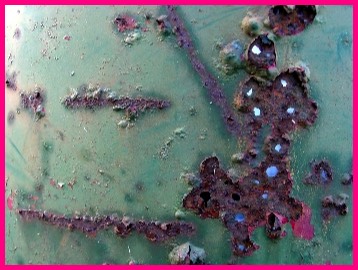Currently viewing
Menu
Pitting Corrosion
Pitting - localized corrosion of a metal surface that is confined to a small area and takes the form of cavities called pits. [1]

Photograph of a Pitted Surface
Showing Full Penetration of the Metal
Pitting or Pitting Corrosion is frequently described as an insidious form of corrosion. Even though the loss of metallic material may be minimal, a pit can rapidly penetrate and destroy the intended function of valuable equipment or components.
There are many similarities between Crevice Corrosion and Pitting. Both have an Initiation Phase and a Propagation Phase. Once initiated, Pitting is believed to follow a similar propagation sequence to Crevice Corrosion. Ultimately, a microenvironment conducive to dissolution is established within the pit.
There are differing views of the initiation mechanism of Pitting, which include: the presence of flaws - the adsorption and penetration of aggressive anions - or breakdown-repair events. Irrespective of the mechanism, it is certain that initiation must involve a localized change in the protective character of the passive film.
Pits come in various shapes and sizes. A pit may be shallow or deep. It may have relatively straight sides or be undercut. In the latter case, the pit diverges from the vertical and may move more in the horizontal plane. There may - or may not - be a deposit of corrosion products on the surface of the metal.
In the case of aluminum alloys, the air-formed film is a poor conductor. However, the presence of precipitates can lead to localized effects. Anodic Precipitates undergo corrosion directly. Cathodic Precipitates are sites for the cathodic reaction, which results in an increase in the pH at the periphery of the precipitate. As aluminum is an "amphoteric metal" (suffers corrosion in both alkaline and acid conditions), an increase in pH can result in corrosion at the periphery of the precipitate.
There are many similarities between Crevice Corrosion and Pitting. Both have an Initiation Phase and a Propagation Phase. Once initiated, Pitting is believed to follow a similar propagation sequence to Crevice Corrosion. Ultimately, a microenvironment conducive to dissolution is established within the pit.
There are differing views of the initiation mechanism of Pitting, which include: the presence of flaws - the adsorption and penetration of aggressive anions - or breakdown-repair events. Irrespective of the mechanism, it is certain that initiation must involve a localized change in the protective character of the passive film.
Pits come in various shapes and sizes. A pit may be shallow or deep. It may have relatively straight sides or be undercut. In the latter case, the pit diverges from the vertical and may move more in the horizontal plane. There may - or may not - be a deposit of corrosion products on the surface of the metal.
In the case of aluminum alloys, the air-formed film is a poor conductor. However, the presence of precipitates can lead to localized effects. Anodic Precipitates undergo corrosion directly. Cathodic Precipitates are sites for the cathodic reaction, which results in an increase in the pH at the periphery of the precipitate. As aluminum is an "amphoteric metal" (suffers corrosion in both alkaline and acid conditions), an increase in pH can result in corrosion at the periphery of the precipitate.
[1] NACE/ASTM G193-10b Standard Terminology and Acronyms Relating to Corrosion, 2010. All rights reserved by NACE. (Reprinted with Permission)
Currently viewing
Page last updated: 12/16/23
